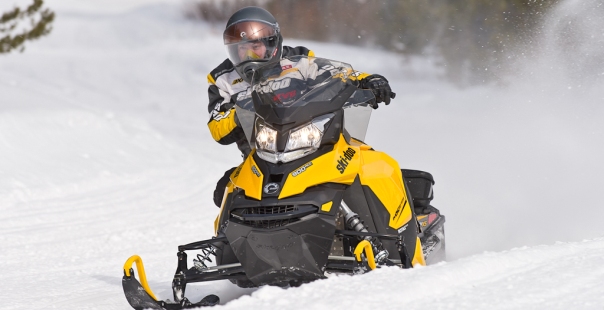We bolted a red-and-black set of Slydog skis to our 2005 Ski-Doo MX Z 600 H.O. “X” to test his claim — sort of. We didn’t have the means to prove whether the snow melted and refroze, and frankly, we didn’t care. What mattered was if the skis helped our REV-based sled gain traction up front.
Slydogs have a unique keel shape that provides more traction without the side-effect of darting. To understand the keel’s design, picture a pyramid that runs the length of the ski with its point stuck to the bottom. This creates two channels to scoop and compress snow. The channel is where Lemme said the snow melts and refreezes, which creates a “rail” for the keel to turn against.
Weight, or lack thereof, is the first thing we noticed about the Slydog skis. The company claims each 6-inch wide ski weighs 5.4 pounds if equipped with a 4-inch carbide. Mass is reduced due to the saddleless design and thin profile.
We installed the skis with a set of 4-inch carbides; the sled’s 1.25-inch lug track had 96 studs in the center belt. Lemme said the skis typically require less carbide than most skis because they work as aggressively as the rider. The harder a driver pushes the ski, the harder it carves its line.
Our first test run proved that the skis help the front end bite better than with the stock Precision skis, but the sled still pushed. We shortened the sled’s front limiter strap 1 inch; that put the front and rear traction in near-perfect balance.
We put more than 1,000 miles on the skis. They greatly improved our sled’s handling characteristics. Drivers felt much more confident that the sled would hold its line through corners. The added control caused a minimal increase in steering effort and darting.
Due to the keel’s scoop design, a few peanut sized rocks got wedged in the keel. We once found a metal chunk of foreign material there, too. The ski has been updated for 2006 to reduce that from happening. At season’s end, the plastic hadn’t faded and looked as good as new on the top side, but the underside was worn.
Slydog skis are made from the same UHMW polyethylene as most other aftermarket and OEM skis, but the soles of our Slydogs look like they suffered more wear than other skis in our fleet.
Wear is affected by trail conditions, and perhaps our MX Z ran on trails with less snow than other sleds. One ski cracked across the keel through the carbide’s front mount hole.
We’re still skeptical about Lemme’s claim, but if the ski meets its goal of improved control, does it matter? Slydog skis provide a significant handling upgrade over Precision skis and other boards that compromise handling to reduce darting and steering effort.




